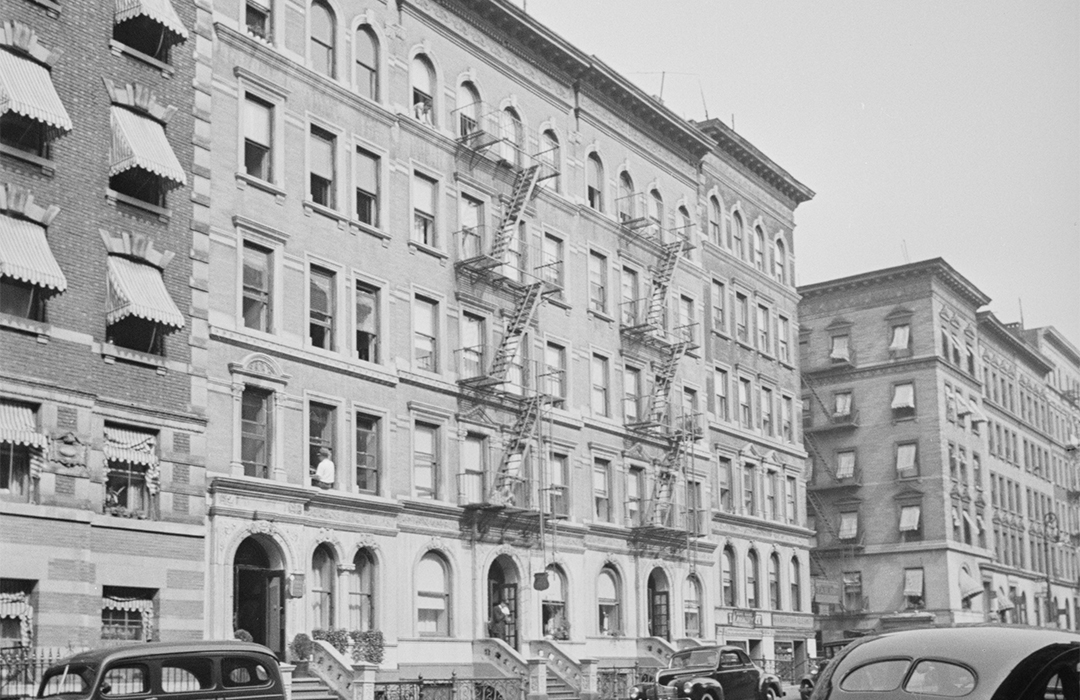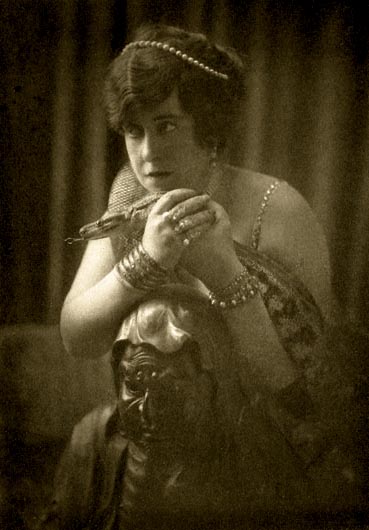
13 + 15 Manhattan Ave.
by Tom Miller
Developer William Rankin erected four five-story apartment buildings at 11 through 19 Manhattan Avenue in 1897. Designed by James W. Cole, they cost $100,000 to build—about $3.9 million in 2025 terms. The two center buildings, 13 and 15 Manhattan Avenue, were identical. Their limestone-clad bases sat above stoops with pierced wing walls. Cole’s Renaissance Revival-style design included triangular pediments at the second floor. Matching cornices with ornate friezes crowned each building.
Arthur T. Morris was an initial resident of 15 Manhattan Avenue. On Christmas Eve 1897, he and two friends, William T. Bauer and Guy Edwards, celebrated in nightclubs. Edwards, said The Sun, “has obtained some notoriety because of his escapes in the Tenderloin.” (The Tenderloin was a notorious district filled with brothels, dance halls, saloons, and gambling houses.) Eventually, the three arrived at the Broadway Garden. The Sun reported, “They walked through to the Broadway side and proceeded to have a war dance.” When a waiter objected to their outburst, Edwards threw a chair at the waiter’s head. The newspaper recounted, “In a very short time a nice row was on. The waiters were made targets for dishes of all sorts and, when no more dishes were within reach, chairs and tables were used for weapons.”
The trio was rounded up and charged at the West 30th Street station house for disorderly conduct. Two days later, they were brought before Magistrate Brann. The Sun reported, “They had no recollection of what had occurred when questioned.” The three were fined $2 each and released.
Next door, residents were dealing with a serious problem. On December 8, 1898, The New York Times reported, “The Board of Health is investigating the condition of a flathouse at 17 Manhattan Avenue, whose tenants complain that they are overrun with rats and mice.”
The situation is somewhat surprising, considering that both were upper-middle class buildings. Living at 15 Manhattan Avenue in 1900, for instance, were James E. Bennet, a commissioner of deeds; Sarah J. Graham, a trained nurse; attorney David Hirschfield; and James Fellows Baldwin, “known throughout the State as a prominent Freemason,” according to The Sun.
“They had no recollection of what had occurred when questioned.”
Baldwin lived here with his wife, Louise. They had two adult children. Born in 1819, he had run his own art printing establishment for decades. He joined the Freemasons before the Civil War and, according to The New York Times, “served in nearly every position in the commandery from Warden to Eminent Commander, and since 1869 had been Prelate. An avid fisherman, The New York Times said he, “never signed any paper, including checks and letters, but that he drew a fish under his name.” He was still actively working at his printing business when he died at the age of 82 on March 13, 1901. The Times remarked that his will, “presented a curious feature, in that just underneath his signature Mr. Baldwin had drawn a picture of a fish.”
Also living at 15 Manhattan Avenue in 1900 were Carrie Sanger and her mother, who had one live-in servant. Carrie worked as a dressmaker and “bears an excellent reputation in the neighborhood,” according to The New York Times on June 4, 1900. Earlier, Carrie’s sister had introduced her to James Edward Davidson, described by The Evening World as “a young Produce Exchange broker.” The two went out a few times, and then Davidson began aggressively stalking her. Carrie told a reporter, “This man has been hounding me wild [with] his attentions.”
On June 4, 1900, The New York Times reported, “A woman put her head out of the window of the top suite in the apartment house at 15 Manhattan Avenue early last night and shouted, ‘Murder!’ Following this with ‘Thieves,’ ‘Robbers,’ and other cries, she shrieked hysterically that a man was trying to kill her and her mother.”
Detective William C. McManus bolted up the stairs and into the Sangers’ apartment. The Times said, “He saw a well-dressed man chasing around the parlor after the young woman who had left the window, and made an effort to get into an alcove.” Carrie’s mother was “shrieking hysterically in a corner.”
Carrie later explained that Davidson appeared at the apartment that evening and, “I ordered him away.” Davidson pushed by her and demanded that she marry him. When she refused, he pulled out a revolver and started shooting. When McManus crashed in, Davidson told him, “I’m going to kill her. I will kill her!” and fired at his moving target again. Now he turned the firearm on McManus, saying, “Move another step and I’ll kill you, too.” McManus leapt forward, jamming Davidson against the wall and smashing his head into a mirror, which crashed to the floor. After a violent struggle, McManus was able to arrest him. The New York Times said that Carrie, “is very much grieved at the notoriety,” and that Mrs. Sanger, “is seriously shocked by the trying ordeal, and both women are under their physician’s care.”
A Mrs. Copeland lived at 15 Manhattan Avenue in 1902 when she received a letter from her sister-in-law, Maude Donnelly. It asked her to visit her that afternoon. Maude Donnelly was formerly a well-known stage actress. She gave up her career when she married Louis Donnelly, “one of the wealthiest men in Atlantic City,” according to The Evening World. The couple separated, and Maude moved back to New York City and into an apartment at 44 West 98th Street. She was very depressed about the failure of her marriage.
Mrs. Copeland, aware of Maude Donnelly’s mental condition, went immediately to the apartment. When her sister-in-law did not answer, she found a Central Park policeman and told him she feared something was wrong. Policeman McNulty climbed down the fire escape and broke in through Maude Donnelly’s window. He found her dead on the kitchen floor, “and by her was a vial which had contained chloroform,” said The Evening World. She left a suicide note to “My dear husband,” and the other (rather considerately) to the coroner.
Bernard Gallagher was a resident of 17 Manhattan Avenue by 1908. Despite his disability (The Evening World described him as “a deaf mute”), he got a job as a checker in a restaurant. On the night of New Year’s Day 1909, he left work and, instead of going home, went downtown to Spring Street to visit his aunt. Just as he emerged from the subway at Lafayette Street, he was accosted by two men. The would-be robbers stole his derby hat and all the money he had on him—ten cents—and then pummeled him mercilessly. The Evening World reported, “The man was badly bruised about the head and neck and two of his teeth were knocked out.”
Living in the building at the time was Stephen A. Dutton. The New-York Tribune said he “has served many years in prison for swindling operations.” He was arrested in November 1909 “on a swindling charge,” and a few days later, on November 9, he was rearrested on another swindling case. This time, reported the New-York Tribune, he “is charged with having palmed off one hundred shares of Northern Pacific stock…on October 4.” He got $6,500 for the worthless stock. He was convicted on the latter charge on December 16, 1910.
Just as he emerged from the subway at Lafayette Street, he was accosted by two men.
Another scammer was Bruno Schill, who ran a steamship ticket agency and lived at 15 Manhattan Avenue in 1921. Through his agency, he acted as the representative of the passport department of the Ukrainian Mission in America. On October 24, 1921, he was arrested on a charge of grand larceny. According to The New York Times, the Cunard Steamship Company accused him “of having passed worthless checks to the amount of $950.” The Cunard representative said the checks were in payment for tickets sold to Ukrainian nationals.
Very soon, Schill had another case to deal with. His wife, Elizabeth (described by The Evening News as “a plump blonde of about thirty-two”) sued Aimee Crocker Gourand, Schill’s mistress, for alienation of her husband’s affections. Schill concocted a way out of his problem. According to Elizabeth, on December 9, David Ostro came to the Schill’s apartment. “He told her there were criminal charges against her husband and asked her to accompany him in order to prevent her husband’s arrest,” reported The Evening World.
He took her to attorney John C. Oldmixon’s office, where she was held against her will and not allowed to use the phone. The two men told her that she would be arrested for blackmail in the Gourand case. Faced with what they said would be certain imprisonment, and concerned about her children at home, she signed the papers dropping the Gourand suit.
But Elizabeth Schill was not that easily gotten rid of. On December 14, 1921, she re-entered her suit against Gourand and charged Oldmixon and Ostro with extortion and kidnapping.
Both buildings continued to house middle- and upper-middle-class residents for the next three decades. Then, in 1952, the city approved the Frederick Douglass Houses, a massive urban renewal project that would eradicate all the structures between 100th to 104th Street and from the east side of Amsterdam Avenue to the west of Manhattan Avenue. Around 1962, 15 and 17 Manhattan Avenue gave way to the project.
Tom Miller is a social historian and blogger at daytoninmanhattan.blogspot.com


